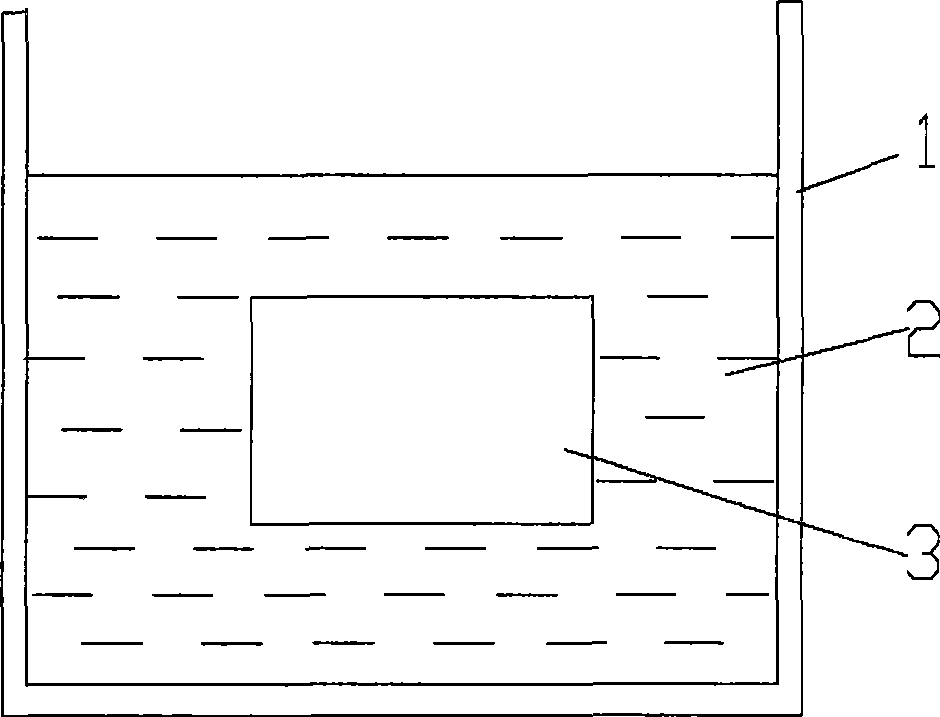Catalyst for chemically enhancing glass and use thereof
A technology of glass strengthening and catalyst, which is applied in the field of chemical catalyst composition and its application, can solve the problems of long strengthening process and low impact resistance of glass, and achieve the effect of increasing glass strength and compressive stress
- Summary
- Abstract
- Description
- Claims
- Application Information
AI Technical Summary
Problems solved by technology
Method used
Image
Examples
Embodiment 1
[0039] The parts by weight of each component of the first catalyst:
[0040] Component A: Potassium Chromate 80 Component B: Potassium Carbonate 50
[0041] The parts by weight of each component of the second catalyst:
[0042] Component C: Potassium Hydroxide 40 Component D: Potassium Silicate 20
[0043] Add the above-mentioned first catalyst to potassium nitrate molten salt E and heat and melt to form a molten salt to obtain the first glass strengthening liquid; add the above-mentioned second catalyst to another potassium nitrate molten salt F to heat and melt to form a molten salt to obtain the second Glass strengthening fluid.
[0044] Wherein potassium nitrate molten salt and the first catalyst weight ratio are 99:1;
[0045] Wherein the weight ratio of potassium nitrate molten salt to the second catalyst is 98.5:1.5.
[0046] The method of using this glass strengthening fluid to increase the strength of glass:
[0047] In step a, the polished soda-lime float glass ...
Embodiment 2
[0050] The parts by weight of each component of the first catalyst:
[0051] Component A: Potassium Chromate 100 Component B: Potassium Carbonate 45
[0052] The parts by weight of each component of the second catalyst:
[0053] Component C: Potassium Hydroxide 1 Component D: Potassium Pyrophosphate 10,
[0054]Add the above-mentioned first catalyst to potassium nitrate molten salt E and heat and melt to form molten salt to obtain the first glass strengthening liquid; add the above-mentioned second catalyst to potassium nitrate molten salt F to heat and melt to form molten salt to obtain the second glass strengthening liquid liquid.
[0055] Wherein the potassium nitrate molten salt and the first catalyst weight part ratio are 98.5:1.5;
[0056] Wherein the weight ratio of potassium nitrate molten salt to the second catalyst is 99:1.
[0057] The method of using this glass strengthening fluid to increase the strength of glass:
[0058] In step a, the polished soda-lime fl...
Embodiment 3
[0061] The parts by weight of each component of the first catalyst:
[0062] Component A: Potassium sulfate 70 Component B: Aluminum oxide 40
[0063] The parts by weight of each component of the second catalyst:
[0064] Component C: Potassium Hydroxide 10 Component D: Potassium Phosphate 80,
[0065] Add the above-mentioned first catalyst to potassium nitrite molten salt E and heat and melt to form a molten salt to obtain the first glass strengthening liquid; add the above-mentioned second catalyst to potassium nitrate molten salt F to heat and melt to form a molten salt to obtain the second glass Strengthening fluid.
[0066] Wherein the potassium nitrite molten salt and the first catalyst weight ratio are 98.5:1.5;
[0067] Wherein the weight ratio of potassium nitrate molten salt to the second catalyst is 99:1.
[0068] Wherein the potassium nitrate molten salt is a mixture of potassium nitrate and potassium chloride, and the potassium chloride accounts for 10% of the...
PUM
| Property | Measurement | Unit |
|---|---|---|
| compressive stress | aaaaa | aaaaa |
| compressive stress | aaaaa | aaaaa |
| compressive stress | aaaaa | aaaaa |
Abstract
Description
Claims
Application Information
 Login to View More
Login to View More - R&D
- Intellectual Property
- Life Sciences
- Materials
- Tech Scout
- Unparalleled Data Quality
- Higher Quality Content
- 60% Fewer Hallucinations
Browse by: Latest US Patents, China's latest patents, Technical Efficacy Thesaurus, Application Domain, Technology Topic, Popular Technical Reports.
© 2025 PatSnap. All rights reserved.Legal|Privacy policy|Modern Slavery Act Transparency Statement|Sitemap|About US| Contact US: help@patsnap.com


